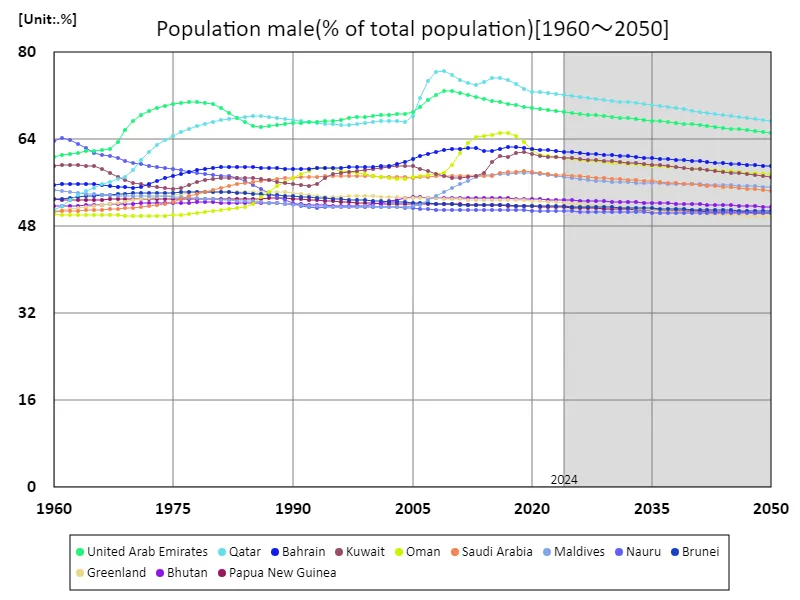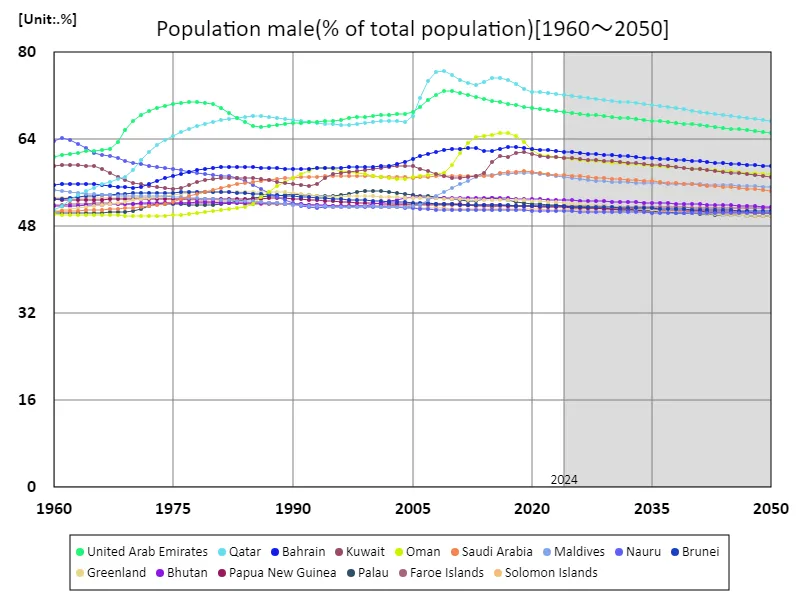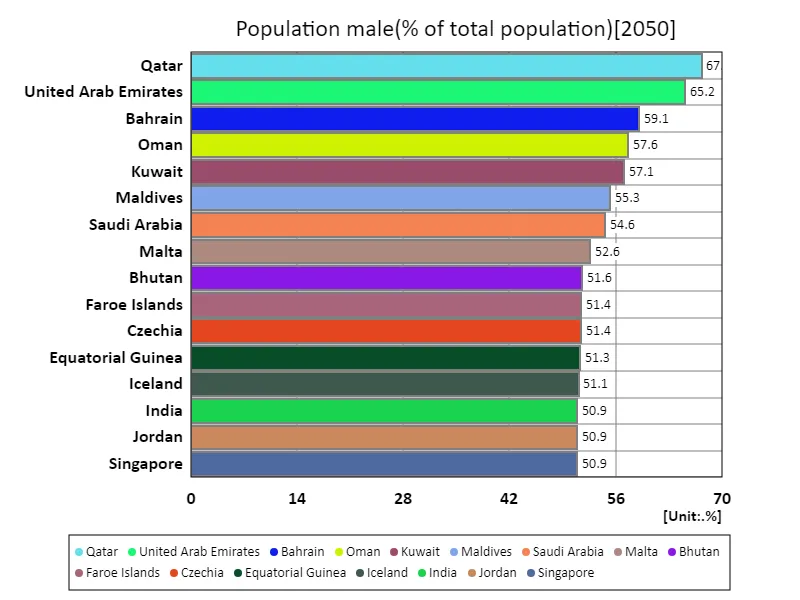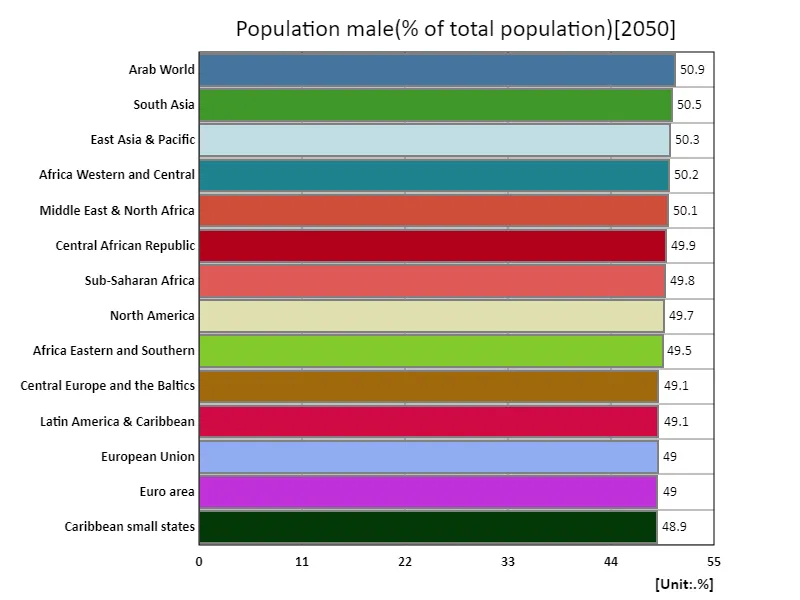Abstract
The proportion of males in the total population varies greatly depending on each country’s social structure, economic activity, immigration policies, etc. For example, a country like Qatar has a very high male population ratio of 67.3%. This is because Qatar’s economy relies on the oil and gas industry and many foreign workers are men. This situation is also influenced by gender bias in the labour market and immigration policies. Meanwhile, in other countries, a relatively equal gender ratio is common. Even in developed and developing countries, the gender ratio varies due to social factors and differences in birth and death rates. For example, while medical advances are helping to create a more balanced gender ratio in developing countries, gender bias still persists in certain regions. In general, countries with a high male population ratio are influenced by dependence on certain industries and immigrant labor, which has a significant impact on their demographic structure. Understanding these trends is an important step towards improving economic policies and social structures.
Male population (percentage of total population)
Between 1960 and 2050, the global male population ratio will undergo significant changes. The data from Qatar is particularly noteworthy. The male population ratio reached 76.6% in 2009 due to the influx of large numbers of male foreign workers into the country’s fast-growing oil and gas industry. This trend continues today, with Qatar’s male population ratio reaching 87.9%. This shows that the country’s economy remains highly dependent on foreign workers. Meanwhile, in other countries, the male population ratio has remained relatively stable overall, although there have been fluctuations in certain regions and countries. For example, in developing countries and countries with rapidly growing economies, changes in the labour market and immigration can affect the male-to-female ratio. In developed countries, the gender ratio is generally relatively equal. Thus, fluctuations in the male population ratio are primarily due to economic structure and immigration policies, and are a particularly clear reflection of gender bias in the labor market. The example of Qatar serves as an important case study for understanding the correlation between economic development and demographic structure.


The maximum is 76.6%[2009] of Qatar, and the current value is about 87.9%
Male population (percentage of total population) (worldwide)
Between 1960 and 2050, there is a notable shift in the male population ratio to the total population. Qatar in particular peaked at 76.6% in 2009 and has now reached an even higher 87.9%. This rapid increase is mainly due to Qatar’s economic reliance on the oil and gas industry and a large influx of male foreign workers. Qatar’s economic growth requires many male workers, especially in the construction and infrastructure development industries, which has led to a significant increase in the male population ratio. In other countries, the male-to-female ratio remains relatively stable but can be affected by immigration and changes in the labour market. For example, developing economies may have higher male population ratios in certain industries or regions, while developed countries generally maintain a closer gender balance to parity. As such, fluctuations in the male population ratio depend heavily on economic structure, labor markets, and immigration policies. The case of Qatar provides an important example for understanding the impact of economic development on demographic structure.


The maximum is 76.6%[2009] of Qatar, and the current value is about 87.9%
Male population (percentage of total population) (worldwide, latest year)
According to data for 2050, the maximum male population ratio in the world will be in Qatar at 67.3%, while the average will be 49.8%. Qatar’s high male population ratio is largely due to the country’s economic structure. In particular, the large influx of foreign male workers in the oil and gas and construction industries has significantly increased the male ratio. This situation is typical when labor demand is significantly gender-biased. With an average male population of 49.8%, the world as a whole has a relatively even gender balance, but there are significant differences between countries. In developing countries and fast-growing economies, the influx of male workers in certain industries can affect the gender ratio. In contrast, developed countries have a more balanced society, with a roughly equal ratio of men to women. The total value of 9.81k% may represent the total data collection or number of countries, but suggests that the percentages of individual countries vary widely. Overall, fluctuations in the male population ratio are often driven by the structure of the economy, immigration policies, and labor market needs.


The maximum is 67.3% of Qatar, the average is 49.8%, and the total is 9.71k%
Male population (percentage of total population) (region, latest year)
According to data for 2050, the maximum ratio of males to the total population will be 50.9% in Arab countries. This is due to the fact that the Arab region still receives a large proportion of male workers. There has been a large influx of male workers in sectors such as the oil and construction industries, which has boosted the overall male ratio. Arab countries tend to have a high male population ratio, particularly as they have a high proportion of foreign workers, most of whom are men. Meanwhile, the global average male population ratio is 49.6%, showing a fairly even gender balance, but with large variations across regions. This reflects differences in economic situations and immigration policies from country to country. While developed countries have a relatively equal gender ratio, regions experiencing rapid economic growth and countries dependent on certain industries tend to have a higher male population ratio. The total figure of 744% may be an indicator for the aggregation of data, but may represent a more complete picture when combined with the individual country ratios. Fluctuations in the male population ratio are strongly linked to the structure of the economy, immigration flows and labour market needs.


The maximum is 50.9% of Arab World, the average is 49.6%, and the total is 744%



Comments